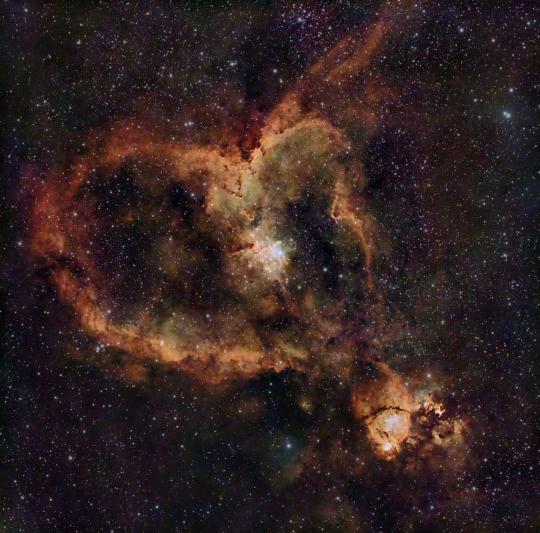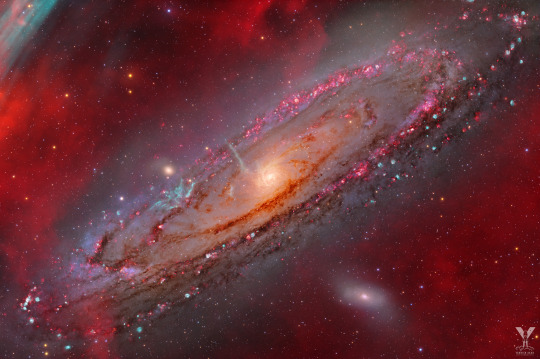#astrobin
Explore tagged Tumblr posts
Text
A few years in the making. As I capture more and more data in this region, I am amazed at the dusty detail that is there. I will continue to capture data on this one into the 32 hour mark. So far about 10 hours of integration time. 25% RGB data and 75% HOO narrowband data for an RGBHOO image.

135 notes
·
View notes
Photo
Usefull Stuff

The Flame nebula I recycled panel one from my mosaic and edited it as it’s own image. Managed to make Alnitak my bitch. That bad boy is a beast that does not wanna be tamed haha. So many cool things in this region.
Data: 🗓 12.11.2021. 🕰 2hrs x 300sec subs, 100gain. 🔭 @skywatcheraustralia F5 750mm Newtonian 📷 ASI533 🕶 Optolong L-enhance 💻 APT, Phd2, Pixinsight, Stellarium, Sharpcap & Photoshop. Darks & Flats
#deepskyphotography #universetoday #outerspace #stars #deepskyobject #spaceart #astrophotography #deepsky #longexposure #nightskyphotography #nightskyporn #apod #aapod2 #skywatcheraustralia #astroworld #cosmos #longexposure #asi533 #nebula #astromaniacmag #telescopes #backyardastronomy #astrobin #astronomy #astrochick #astromaniacmag #flamenebula https://www.instagram.com/p/CWP1YoQJwEp/?utm_medium=tumblr
#deepskyphotography#universetoday#outerspace#stars#deepskyobject#spaceart#astrophotography#deepsky#longexposure#nightskyphotography#nightskyporn#apod#aapod2#skywatcheraustralia#astroworld#cosmos#asi533#nebula#astromaniacmag#telescopes#backyardastronomy#astrobin#astronomy#astrochick#flamenebula
1 note
·
View note
Text

"Colors of the Night - Iceland" (a winter night). Photo © Louis Leroux. AstroBin image of the day 6 June '25. Part of the image includes Airglow. Photographer's description: "The second striking phenomenon, covering the entire sky, is airglow. These colorful bands stretching across the sky result from complex chemical reactions occurring in the upper atmosphere, specifically in the thermosphere, which is a layer within the ionosphere. Caused by solar radiation, powerful ultraviolet rays dissociate certain molecules in Earth's atmosphere. These excited molecules then emit a faint glow in the dark night, a phenomenon known as chemiluminescence. The red color comes from hydroxyl molecules. Sodium and oxygen atoms rise to about 100 km in altitude and produce green or even orange light. Blue airglow is much rarer and occurs even higher up. A recent study has confirmed a link between this phenomenon and gravity waves."
#Louis Leroux#photography#aurora borealis#airglow#gravity waves#zodiacal light#milky way galaxy#Iceland#AstroBin iotd#cosmic skies & clouds
12 notes
·
View notes
Text

The Pacman Nebula, NGC 281 // Ani Shastry
Please go see this picture on Astrobin; it was over 100 Mb!
#astronomy#astrophotography#nebula#emission nebula#star-forming region#pacman nebula#NGC 281#Sh2-184#cassiopeia
125 notes
·
View notes
Text
I found the astrobin for HD231280. It's part of the constellation Aquila.
And here are some of the example "swatches" for images in their search. This is just 4 of 14, and if you go to the link you can roll over and click on each swatch for a full image and technical details.

I've heard some theories that Angel!Crowley was working with the Book of Life, so I thought I'd share this well-timed screen grab.
The book says, "Nebula 231,280." 281? Hard to see clearly.

So, no, that is not the Book of Life.
However, it does imply that Heaven has a library. An enormous one, at that, if every piece of creation has its own book.
Aziraphale is going to sniff out these books in Heaven like a pig to truffles, I tell you.
230 notes
·
View notes
Text

Vela Supernova Remnant taken on February 6 2021 by jeff2011 on Astrobin
The supernova remnant resides within the Vela constellation, having exploded over ten thousand years ago. It is the closes supernova remnant to Earth. Observational data from this remnant provided proof that supernova’s can produce neutron stars.
Supernovas occur at the end of a star’s life. Stars with mass over eight solar masses finish burning the hydrogen in their core and become a red supergiant. Successive fusion then occurs until the core contains iron. Fusion can no longer occur at iron since it is not energetically favorable. Gravity then takes over leading to a supernova explosion— expelling a huge amount of stellar material.
Neutron stars can form as a result of this, as protons and electrons collide to combine into neutrons. The neutron stars are stable by neutron degeneracy pressure. This pressure is caused the Pauli Exclusion principal which prevents neutrons from having the same positions.
#physics#physics student#astrophysics#astrophotography#astronomy photography#astronomy#cosmology#cosmos#supernova#nasa science#nasa#space#spaceblr#outer space#photography#space photography#science#stemblr#stem#physblr#eclipsellium
23 notes
·
View notes
Text

Ok, so I was searching for information on some of the objects visible in my photo of the horse head nebula and I found these two posts (Reddit and Astrobin) by DanielZoliro that also used a SII and Ha combination but with a slightly different processing (Notably, the RGB combination being R: SII, G: 0.6xHa + 0.4xSII, B: Ha). I loved his results and I had to try it with my own data. Did turn out great, but there was a reflection of a star on the SII data and this processing amplified it (the big reddish round/donut thing on right of the full image).

(Image taken using a CarbonStar 150/600 newtonian telescope with a 0.95 coma corrector, ZWO ASI294 monochrome camera and Baader 6.5nm SHO filter. 5x120s image for each colour filter (RGB), 22x300s for the Ha filter and 32x300s for the SII filter, total imaging time 5h, stacking and processing done in PixInsight.)
#astronomy#astrophotography#space#photos taken from my backyard#nebula#horse head nebula#ic 434#flame nebula
21 notes
·
View notes
Text

There is no-thing to find. There is nowhere to go. Consciousness is now. All Love is here now. Grace is waiting patiently for all of you beyond the ego-mind, outside of all beliefs, where there is no 'I.'
The silent Awareness within me is the One silent Awareness within you. You are already awake.
You are me, and I am you, where the 'I' disappears.
Padmā
Image: NGC 3576 - The Statue of Liberty Nebula. An astrophotograph by Matthew Russell on AstroBin
36 notes
·
View notes
Text
IC 1805, aka The Heart Nebula. Using a William Optics Redcat 51-II-U telescope, using an Optolong L-Quad filter. Stacked 72 300s images. Astrobin link in comments.

This image does not include any data from my previous attempt at imaging the Heart Nebula. This is new data using a different filter.
#astronomy#nasa#astronomers#universe#astrophotography#nasa photos#nasawebb#astrophysics#outer space#hubble space telescope#nebulosa#nebula#cosmos#galaxies#galaxy#goddard space flight center#james webb images#hubble#astrology#astro community#astro notes#astro observations#astroblr#astrology observations#astronauts#space exploration#space#space photography#space science#our universe
110 notes
·
View notes
Text
M8 (NGC 6523) — The Lagoon Nebula
youtube
It is considered to be the second brightest nebula in the Earth’s sky, and one of two hydrogen nebulae visible to the naked eye (for an observer in the middle latitudes of the Northern Hemisphere). The first to come to mind is the Orion Nebula. Is there anything comparable to it in the sky? — Yes — There is the Lagoon Nebula.
But it is not easy to see the Lagoon with the naked eye. Its integral brightness is about 6m — right at the limit of the eye’s penetrating ability. If it is possible to see it without optics somewhere, then only high in the mountains. And it is not at all surprising that the Lagoon was discovered using a telescope, even the simplest one. Different sources give different discoverers. It is believed that this nebula was observed by Giovanni Hodierna back in 1654 or even earlier — in fact, in the era of Galileo. But then, telescopic study of the skies was not yet mainstream in astronomy, not everyone was in a hurry to talk about it. And Hodierna’s discovery did not become generally known at the time. That is why the French astronomer Guillaume le Gentil, who discovered a wispy foggy cloud in the constellation Sagittarius a century later, is sometimes mentioned as the discoverer of the Lagoon Nebula.
The Lagoon is located literally in the direction of the center of the Milky Way Galaxy, at a distance of 5,200 light years from us (until recently, distance estimates varied greatly — from 4 to 6 thousand light years, but in any case, the Lagoon is still very far from the center of the Milky Way). Interestingly, the famous Orion Nebula, often mentioned in connection with the Lagoon, is located almost in the opposite direction — away from the center of the Galaxy (but a little closer to us — 1,300 light years, which means that the Lagoon is much larger and brighter than the Orion Nebula … would be under equal conditions).
The M8 nebula has a physical diameter of 50 to 100 light years (it is oblong), in its huge volume young hot — sometimes very massive — stars are intensively born. It is the same maternity hospital for new galactic luminaries as the Orion Nebula.
The lagoon is adjacent to a large number of other interesting objects, which the constellation Sagittarius is rich in. Sometimes it seems that Sagittarius has attracted most of the pearls of visual and photographic astronomy. But the center of the Galaxy is to blame for everything — it is to it that both Nebulae and star clusters gravitate, which are most often present in the central parts of hydrogen nebulae — they are born in them. Laguna also has its own cluster — NGC 6530.
The visualization provided as an example is based on an astrophotography by Andre Helmuth and Jan Beckman, published on the Astrobin website — there this image became the winner of regular ratings, and in terms of detail it competes with the best professional photographs, although it was made using a telescope with a mirror diameter of 12 inches — quite serious, but not too big in comparison with the multi-meter giants of the top observatories.

8 notes
·
View notes
Text
Doing some more "staying warm observing" with the SeeStar tonight. Moon, m63 and m101. These were processed on my phone only using android software and SeeStar software. #astrophotography 🔭



15 notes
·
View notes
Text

M42 Great Orion Nebula by Jim Mc Kee (Astrobin)
3 notes
·
View notes
Text

Andromeda Galaxy, astrophotography by Yannick Akar. Photographer's words: "In a captivating endeavour spanning two seasons, I captured the mesmerising beauty of the Andromeda galaxy using broadband and narrowband filters. All the broadband data was captured in the 2022 season, with an additional 38 hours of H-Alpha data. The 2023 season was dedicated to collecting some more H-Alpha data and all the Oxygen data." (more at the link)
1 note
·
View note
Text

Looking towards the center of the Milky Way // Drew Evans
Several nebulae are visible here, can you identify them all?
Please go look at this image on astrobin. I had to significantly shrink the file to fit on Tumblr!
#astronomy#astrophotography#galaxy#spiral galaxy#star-forming galaxy#milky way#milky way galaxy#nebula#emission nebula#dark nebula#dust#interstellar dust#star-forming region#sagittarius
67 notes
·
View notes
